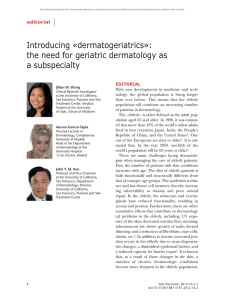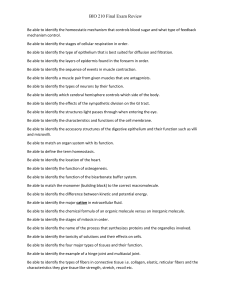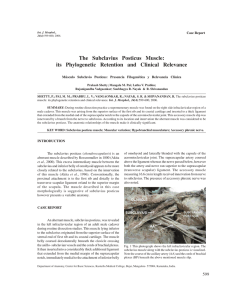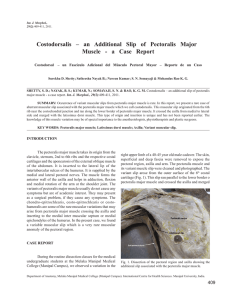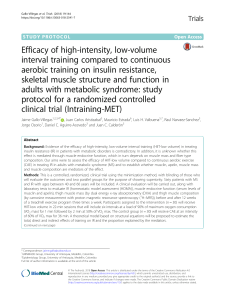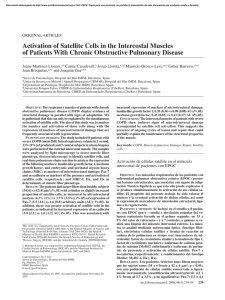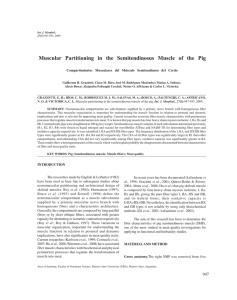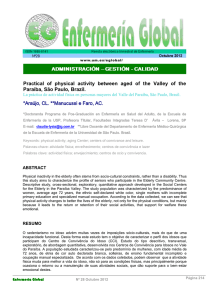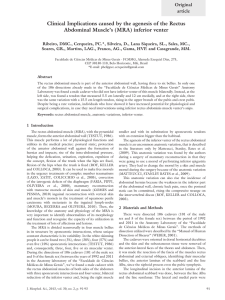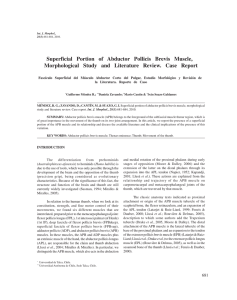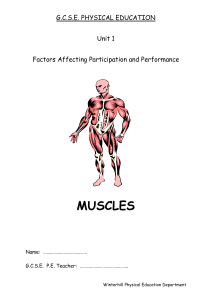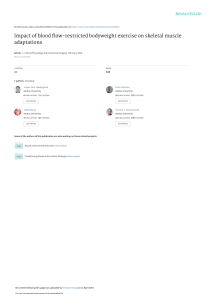Decreasing physical fitness due to age
Anuncio
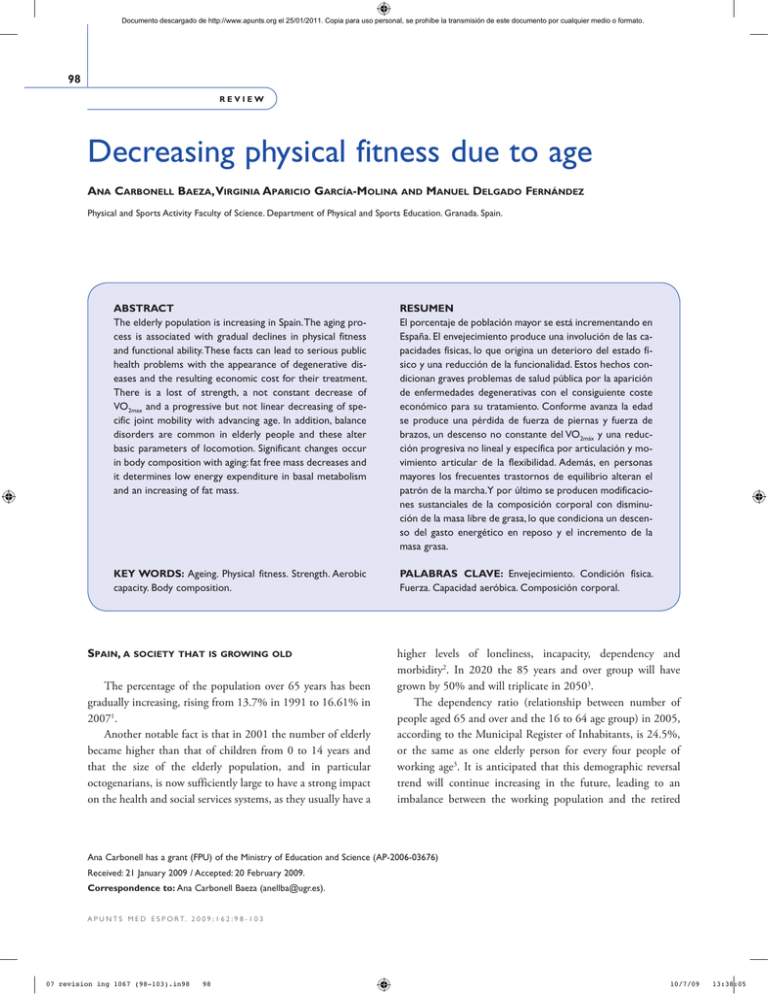
Documento descargado de http://www.apunts.org el 25/01/2011. Copia para uso personal, se prohíbe la transmisión de este documento por cualquier medio o formato. 98 REVIEW Decreasing physical fitness due to age Ana Carbonell Baeza, Virginia Aparicio García-Molina and Manuel Delgado Fernández Physical and Sports Activity Faculty of Science. Department of Physical and Sports Education. Granada. Spain. ABSTRACT The elderly population is increasing in Spain. The aging process is associated with gradual declines in physical fitness and functional ability. These facts can lead to serious public health problems with the appearance of degenerative diseases and the resulting economic cost for their treatment. There is a lost of strength, a not constant decrease of VO2max and a progressive but not linear decreasing of specific joint mobility with advancing age. In addition, balance disorders are common in elderly people and these alter basic parameters of locomotion. Significant changes occur in body composition with aging: fat free mass decreases and it determines low energy expenditure in basal metabolism and an increasing of fat mass. RESUMEN El porcentaje de población mayor se está incrementando en España. El envejecimiento produce una involución de las capacidades físicas, lo que origina un deterioro del estado físico y una reducción de la funcionalidad. Estos hechos condicionan graves problemas de salud pública por la aparición de enfermedades degenerativas con el consiguiente coste económico para su tratamiento. Conforme avanza la edad se produce una pérdida de fuerza de piernas y fuerza de brazos, un descenso no constante del VO2máx y una reducción progresiva no lineal y específica por articulación y movimiento articular de la flexibilidad. Además, en personas mayores los frecuentes trastornos de equilibrio alteran el patrón de la marcha.Y por último se producen modificaciones sustanciales de la composición corporal con disminución de la masa libre de grasa, lo que condiciona un descenso del gasto energético en reposo y el incremento de la masa grasa. KEY WORDS: Ageing. Physical fitness. Strength. Aerobic capacity. Body composition. PALABRAS CLAVE: Envejecimiento. Condición física. Fuerza. Capacidad aeróbica. Composición corporal. Spain, a society that is growing old The percentage of the population over 65 years has been gradually increasing, rising from 13.7% in 1991 to 16.61% in 20071. Another notable fact is that in 2001 the number of elderly became higher than that of children from 0 to 14 years and that the size of the elderly population, and in particular octogenarians, is now sufficiently large to have a strong impact on the health and social services systems, as they usually have a higher levels of loneliness, incapacity, dependency and morbidity2. In 2020 the 85 years and over group will have grown by 50% and will triplicate in 20503. The dependency ratio (relationship between number of people aged 65 and over and the 16 to 64 age group) in 2005, according to the Municipal Register of Inhabitants, is 24.5%, or the same as one elderly person for every four people of working age3. It is anticipated that this demographic reversal trend will continue increasing in the future, leading to an imbalance between the working population and the retired Ana Carbonell has a grant (FPU) of the Ministry of Education and Science (AP-2006-03676) Received: 21 January 2009 / Accepted: 20 February 2009. Correspondence to: Ana Carbonell Baeza ([email protected]). a p u n t s m e d e s p o r t. 2 0 0 9 ; 1 6 2 : 9 8 - 1 0 3 07 revision ing 1067 (98-103).in98 98 10/7/09 13:38:05 Documento descargado de http://www.apunts.org el 25/01/2011. Copia para uso personal, se prohíbe la transmisión de este documento por cualquier medio o formato. 99 REVIEW How does ageing influence the physical condition? Ageing associated with growing older is strongly linked to the deterioration in human physical qualities. Therefore, knowledge of how these qualities evolve and how can they be developed, will ensure, on the one hand, a better understanding of how a person is older, and on the other, how to deal with it to be able to lessen this deterioration. The effect of ageing in each of these physical qualities is analysed below. Upper body strength Hand-grip is reduced with increasing age in women7,8 and men8,9. Forres et al9 performed a cross-sectional and longitudinal study of 7 years with men between 51 and 84 years and found that those over 75 years had 27.6% less strength than those less Figure 1 Changes in handgrip strength across the age. Results from the study of Nuñez et al10. 28 Figura superi estudi 26 Hand grip values (Kg) population. This requires directing scientific and health resources, not only to treat the various diseases that are associated with ageing, but also to promote healthy ageing. Ageing is an easily influenced physiological process. This influence may be negative (accelerating it) or positive (delaying it). Given that the main characteristic of ageing is the gradual loss of functions, and since this and death are not genetically programmed, it is possible to delay or reduce this functional decline, improve health and wellbeing both physically and mentally. This may be done, firstly, by avoiding risk behaviour (for example, smoking, excessive alcohol consumption, excessive exposure to the sun and obesity) which speeds up the onset of diseases linked to age. Secondly, adopting behaviours that are of benefit to a physiology that is inherently modifiable; such behaviours are the habitual practice of exercising (which keeps the body in good shape) and following a healthy diet4. Castillo5 states that suitable physical exercise, practised regularly, is the best tool available today to promote personal health and wellbeing. When it is carried out appropriately (which is not an easy task), the benefits of exercise are always produced, regardless of age, state of health and physical condition that the person has. Prescriptive interventions directed at the general population have been oriented towards the improvement of aerobic capacity, body composition, coordination abilities of the physical condition, metabolic fitness and mood6. It is essential to take into account the biological state of the elderly person when designing and developing these. Figure inferio by Nu 24 22 20 18 16 20-34 35-44 45-54 55-64 > 64 INSER in Kg/ INSER movem Age than 60. The longitudinal study showed a mean rate of decrease of 2.8% per year. The analysis by age groups showed that that rate was 2% in those less than 60 years and 3.4% in those over 75 years. These researchers published a repeat of this study 2 years later with women7. They performed a cross-sectional study with 9372 women from 65 to 99 years old. They found that women from 75 to 99 years had 10% less hand-grip strength than those from 60 to 69 years, whereas those over 80 years had 14% less than the 70 to 74 year-olds. They also carried out a longitudinal study, and at 10 years they saw that the mean loss was 2.4% per year. The loss was greater as the age range increased. At 10 years they saw a decrease of 19.4% in the 65 to 69 years group, 23.4 % in the 70 to 74 years group, 24.3% in those from 75 to 79 years, and for the over 80 years group it was 28.6%7. Nuñez et al10 carried out a cross-sectional study where they analysed the hand-grip pressure of healthy women from 20 to 80 years old and found that upper body strength decreased significantly from 64 years onwards. The mean pressure for the women over 64 year-olds was 17.95 Kg, which represents a decrease of 21.28% when compared to women from 45 to 64 years, and 34.22% compared to women from 20 to 44 years old (fig. 1). Lower body strength The loss of leg strength is greater than that of the arms11. Goodpaster et al12 analysed leg extensor strength in 3075 men a p u n t s m e d e s p o r t. 2 0 0 9 ; 1 6 2 : 9 8 - 1 0 3 07 revision ing 1067 (98-103).in99 99 10/7/09 13:38:06 Documento descargado de http://www.apunts.org el 25/01/2011. Copia para uso personal, se prohíbe la transmisión de este documento por cualquier medio o formato. 100 REVIEW Figure 2 Changes in lower limb strength across the age. Results from the study of Nuñez et al10. Mean counter movement jump (cm) 22 muscle are associated with limited mobility in older men and women21, which is why it has to be a preferred quality to include when designing intervention programmes for this population group. 20 18 Aerobic capacity 16 The rate of decrease of the VO2max is not constant throughout life, but it accelerates significantly with each decade, and is greater in men than in women22-24. In a review performed by Hawkins and Wisswell25 on the percentage decreases in VO2max obtained in both cross-sectional and longitudinal studies, they came to the conclusion that the normal rate of decrease was approximately 10% every ten years. Stathokostas et al24 in their study found that, although men had a higher initial VO2max, the percentage decrease in 10 years was 14.7% in men and 7% in women from 55 to 84 years. They did not find any significant changes in the anaerobic threshold in men or women, or in the percentage VO2max in which the anaerobic threshold is situated, confirming that this threshold has rate of decrease less than the VO2max. According to Weiss et al26 the decrease in the VO2max due to age after 60 years is caused by a drop in maximum cardiac output, as well as by a reduction in the arterial/venous oxygen difference. These reductions take place more rapidly in men than in women, although these differences between sexes tend to vanish in the last decades of life. The reduction in cardiac output associated with age is basically due to a decrease in the maximum heart rate. According to Hollengber et al22, the maximum heart rate and forced expiratory volume in one second largely explains the decrease in aerobic capacity due to age. The drop in aerobic capacity has significant implications as regards functional independence and quality of life, not only in the healthy elderly, but particularly when they are added to the deficiencies from various associated diseases23. Therefore as strength, aerobic capacity should be worked on as a matter of priority. 14 12 10 8 6 20-34 35-44 45-54 55-64 > 64 Age and women from 70 to 79 years in a 3-year longitudinal study and obtained annual rates of decrease of 3.4% and 4.1% in Caucasian and non-Caucasian males, respectively, and 2.6% and 3% in Caucasian and non-Caucasian women, respectively, whereas the annual rate of muscle mass loss was 1%. There is a correlation between increasing age and a low muscle mass13, but the loss of muscle strength is not due exclusively to loss of muscle mass12,14. Age, initial strength level, loss of muscle mass, decrease in height, low level of physical activity, state of health in diseases such as arthritis and diabetes or falls contribute to the loss of strength due to advancing age7,12,13. Nuñez et al10 analysed the explosive length strength in healthy women from 20 to 80 years and found that the greatest decreases were produced from 44 years (23 % compared with the 20 to 34 years age group) and from 64 years (30% decrease compared to women from 55 to 64 years), as can be seen in Figure 2. This decrease in explosive strength is demonstrated in several studies, where on comparing the results obtained with a counter movement jump by young adults with older ones, the latter had significantly lower values15,16. Several studies have confirmed that low muscle strength, in the legs as well as the hand-grip, is a strong and independent predictor of mortality in old people17-19. Scientists suggest that hand-grip strength can also be a method for detecting sarcopenia8, this being seen as a loss of muscle mass. Sarcopenia is common in people over 65 years and increases with age20. A low muscle mass (cross-sectional area of a small muscle), a low level of muscle strength and a high level of fat in the Flexibility Flexibility reduces gradually, but this is not linear as age advances27,28. The mean values tend to be systematically higher in women than in men, even at younger ages. After 60 years the difference increases, women being between 20 or 40% more flexible than men27, but other authors conclude that the effect of gender is weaker than that of age28. The effect of age is specific for each joint and particular movement. Doriot and a p u n t s m e d e s p o r t. 2 0 0 9 ; 1 6 2 : 9 8 - 1 0 3 07 revision ing 1067 (98-103).in100 100 10/7/09 13:38:06 Documento descargado de http://www.apunts.org el 25/01/2011. Copia para uso personal, se prohíbe la transmisión de este documento por cualquier medio o formato. 101 REVIEW Wang28 compared the maximum ranges of joint movements of the upper body between young (25 to 35 years) and older adults (65 to 80 years) and found that the maximum loss is observed in the neck, particularly in lateral extension and flexion (more than 40% decrease), and in the trunk, in lateral flexion (greater than 33% loss) and axial rotation (a reduction of more than 16%). The shoulder joints decrease by 25% in flexion and 10% in adduction. No effects with age were observed in the elbow and wrist joints. In line with these results, Sforza et al29 observed that the neck movement range decrease between 15 and 45 years of age in healthy men, and Barnes et al30 concluded that the passive and active movement ranges, except for the internal rotation, of the shoulder decreased with age between 4 and 70 years. Women have higher movement ranges than men in that joint. Troke et al31 provided some data on normal movements of the lower spine in 16 to 90 year-olds, determining that the frontal and lateral flexion decreases 45% and 48%, respectively, throughout the age range. Extension is reduced in 79% and, on the contrary, axial rotation does not decrease. In the the lower body, the movement range of the knee joint tends to decrease with increasing age32. Balance Balance or equilibrium disorders are common in the elderly. Balance is a significant risk factor for falls, and is affected by the gradual loss of motor sensory function associated with increasing age33. Deficiencies in proprioception, sight, vestibular sense, muscle function and reaction time all contribute to balance disorders. This shows up as a low performance in tasks such as standing, bending, climbing stairs, walking and responding to external disturbances33. Amiridis et al34 examined how the young and old adapted their posture in static equilibrium tasks which were increased in difficulty (normal upright static posture, tandem Romberg and one leg stance). Older people showed pressure centres and joint movements, as well as an electromyography activity, higher than young adults. This increase in postural demand in the elderly brings about greater movement of the hip compensated by increased muscle activity in this area, a finding not seen in young people. Madhavan and Shields35 observed how young people (<30 years) were able to maintain one legged static balance with eyes shut for a mean of 48.2 seconds, while the elderly (>60 years) it was only 4.5 seconds. They attributed these results to a decrease in proprioception and vestibular function in the older people. According to a longitudinal study carried out by Baloh et al36 there is a decrease due to age in the vestibular, visual, hearing and somatosensory capacity, but, for these authors, these changes are only weakly associated with changes in balance and gait. Dynamic position sense decreases with age35. The locomotion pattern is altered, with a reduction in walking speed8,37-40, an increase in two-leg support, a decrease in stride length39,40 and reduced ankle dorsiflexion during the aerial phase compared with young adults. This entails serious risks when the foot comes into contact with obstacles38. If performing a cognitive task is added to the gait, its speed decreases even more37. The speed and the execution cycle of climbing steps are also altered, since the elderly remain longer in the double support phase with one foot on the floor and the other on the step, there is greater forward flexion of the trunk, greater hip flexion and less dorsal flexion of the ankle than young adults during the execution of this task41. Body composition The fat-free mass remains stable during the first decades of life in both sexes, but then there is an accelerated decrease that starts after 50 years in men and after 60 years in women23. Longitudinal studies carried out with the elderly have confirmed a decrease in height and fat-free mass with increasing age42,43. Fat mass, on the other hand, tends to increase in the elderly44. Kyle et al45 found a clear relationship between age or a low level of physical condition and body composition parameters adjusted for height. The elderly have are more likely to have a low fat-free mass and a high or very high body fat mass. As well as these changes in body composition, there is also a decrease in resting energy expenditure as age increases, although this decrease is not wholly due to these body composition changes46,47. The situation is that, according to a study carried out by Andreyeva et al48, Spain has the highest prevalence of obesity among men (20.2%) and women (25.6%) over 50 years old. They analysed obesity and overweight in 10 developed European countries and found that both obesity and overweight were associated with chronic health conditions, such as diabetes, high blood cholesterol, hypertension and arthritis. This rapid growth in obesity compared to previous decades and the differences found between different countries with similar populations indicate that the causes of obesity are environmental and the reason for its prevalence is social. a p u n t s m e d e s p o r t. 2 0 0 9 ; 1 6 2 : 9 8 - 1 0 3 07 revision ing 1067 (98-103).in101 101 10/7/09 13:38:07 Documento descargado de http://www.apunts.org el 25/01/2011. Copia para uso personal, se prohíbe la transmisión de este documento por cualquier medio o formato. 102 REVIEW Conclusions Ageing comes with a loss of physical abilities with the resulting deterioration in function. As age advances there is a loss of leg strength, which is greater than that lost in the arms. The aerobic capacity decreases, but the rate of the drop in VO2max is not constant. There is a gradual, but non-linear, reduction in flexibility and the effect of age is specific for each joint and joint movement. Balance disorders are common in the elderly and there are changes in walking patterns. Fat-free mass decreases with increasing age, as well as resting energy expenditure but, on the other hand, fat mass tends to increase. References 1. Demografía. Anuario Estadístico de España 2008. Madrid: Instituto Nacional de Estadística; 2008. 2. Informe 2006. Las personas mayores en España. Madrid: Ministerio de Trabajo y Asuntos Sociales. Secretaría de Estado de Servicios Sociales, Familias y Discapacidad. Instituto de Mayores y Servicios Sociales (IMSERSO); 2006. 3. INE. 1 de octubre. Día internacional de las personas mayores. Cifras INE 2006. Disponible en: http://www.ine.es/prodyser/ pubfolletos.htm 4. Castillo MJ, Ortega F, Ruiz J. Mejora de la forma física como terapia antienvejecimiento. Med Clin (Barc). 2005;124:146-5. 5. Castillo M. La condición física es un componente importante de la salud para los adultos de hoy y del mañana. Selección. 2007;17:2-8. 6. Kahn EB, Ramsey LT, Brownson RC, Heath GW, Howze EH, Powell KE, et al. The effectiveness of interventions to increase physical activity. A systematic review. Am J Prev Med. 2002;22 Suppl 4:73-107. 7. Forrest KY, Zmuda J, Cauley J. Patterns and correlates of muscle strength loss in older women. Gerontology. 2007;53:140-7. 8. Lauretani F, Russo CR, Bandinelli S, Bartali B, Cavazzini C, Di Iorio A, et al. Age-associated changes in skeletal muscles and their effect on mobility: an operational diagnosis of sarcopenia. J Appl Physiol. 2003;95:1851-60. 9. Forrest KY, Zmuda J, Cauley J. Patterns and determinants of muscle strength change with aging in older men. The Aging Male. 2005;8:151-6. 10. Nuñez JP, Carbonell A, Burgos MA, Nuñez FJ, Padial P. Evolución de la fuerza del tren superior e inferior en mujeres sanas de 20 a 80 años. III Congreso de la Asociación Española de Ciencias del Deporte. Valencia: Universidad de Valencia; 2004. 11. Landers KA, Hunter GR, Wetzstein CJ, Bamman MM, Weinsier RL. The interrelationship among muscle mass, strength, and the ability to perform physical tasks of daily living in younger and older women. J Gerontol A Biol Sci Med Sci. 2001;56:B443-8. 12. Goodpaster BH, Park SW, Harris TB, Kritchevsky SB, Nevitt M, Schwartz AV, et al. The loss of skeletal muscle strength, mass, and quality in older adults: the health, aging and body composition study. J Gerontol A Biol Sci Med Sci. 2006;61:1059-64. 13. Sayer AA, Dennison EM, Syddall HE, Jameson K, Martin HJ, Cooper C. The developmental origins of sarcopenia: Using peripheral quantitative computed tomography to assess muscle size in older people. Journal of Gerontology: Medical Sciences. 2008; 63A:835-40. 14. Beliaeff S, Bouchard D, Hautier C, Brochu M, Dionne IJ. Association between muscle mass and isometric muscle strength in well-functioning older men and women. Journal of Aging and Physical Activity. 2008;16:484-93. 15. Izquierdo M, Aguado X, Gonzalez R, Lopez JL, Häkkinen K. Maximal and explosive force production capacity and balance performance in men of different ages. European Journal of Applied Physiology and Occupational Physiology. 1999;79:260-7. 16. Izquierdo M, Ibañez J, Gorostiaga EM, Garrues M, Zuñiga A, Antón A, et al. Maximal strengh and power characteristics in isometric and dynamic actions of the upper and lower extremities in middleaged and older men. Acta Physiol Scand. 1999;167:57-68. 17. Ruiz J, Sui X, Lobelo F, Morrow J, Allen W, Jackson JA, et al. Association between muscular strength and mortality in men: prospective cohort study. BMJ. 2008;337-439. 18. Gale CR, Martyn CN, Cooper C, Sayer AA. Grip strength, body composition, and mortality. Int J Epidemiol. 2007;36:228-35. 19. Newman AB, Kupelian V, Visser M, Simonsick EM, Goodpaster BH, Kritchevsky SB, et al. Strength, but not muscle mass, is associated with mortality in the health, aging and body composition study cohort. J Gerontol A Biol Sci Med Sci. 2006;61:72-7. 20. Iannuzzi-Sucich M, Prestwood KM, Kenny AM. Prevalence of sarcopenia and predictors of skeletal muscle mass in healthy, older men and women. J Gerontol A Biol Sci Med Sci. 2002;57:M772-7. 21. Visser M, Goodpaster BH, Kritchevsky SB, Newman AB, Nevitt M, Rubin SM, et al. Muscle mass, muscle strength, and muscle fat infiltration as predictors of incident mobility limitations in well-functioning older persons. J Gerontol A Biol Sci Med Sci. 2005;60:324-33. 22. Hollenberg M, Yang J, Haight TJ, Tager IB. Longitudinal changes in aerobic capacity: Implications for concepts of aging. Journal of Gerontology: Medical Sciences. 2006;61A:851-8. a p u n t s m e d e s p o r t. 2 0 0 9 ; 1 6 2 : 9 8 - 1 0 3 07 revision ing 1067 (98-103).in102 102 10/7/09 13:38:07 Documento descargado de http://www.apunts.org el 25/01/2011. Copia para uso personal, se prohíbe la transmisión de este documento por cualquier medio o formato. 103 REVIEW 23. Fleg JL, Morrell CH, Bos AG, Brant LJ, Talbot LA, Wright JG, et al. Accelerated longitudinal decline of aerobic capacity in healthy older adults. Circulation. 2005;112:674-82. 24. Stathokostas L, Jacob-Johnson S, Petrella RJ, Paterson D. Longitudinal changes in aerobic power in older men and women. J Appl Physiol. 2004;97:784-9. 25. Hawkins SA, Wisswell RA. Oxygen consumption decline with aging implications for exercise training. Sports Med. 2003;33:87788. 26. Weiss EP, Spina RJ, Holloszy JO, Ehsani AA. Gender differences in the decline in aerobic capacity and its physiological determinants during the later decades of life. J Appl Physiol. 2006; 101:938-44. 27. Araujo C. Flexibility assessment: normative values for flexitest from 5 to 91 years of age. Arq Bras Cardiol. 2008;90:257-63. 28. Doriot N, Wang X. Effects of age and gender on maximum voluntary range of motion of the upper body joints. Ergonomics. 2006;49:269-81. 29. Sforza C, Grassi G, Fragnito N, Turci M, Ferrario VF. Three-dimensional analysis of active head and cervical spine range of motion: effect of age in healthy male subjects. Clin Biomech (Bristol, Avon). 2002;17:611-4. 30. Barnes CJ, Van Steyn SJ, Fischer RA. The effects of age, sex, and shoulder dominance on range of motion of the shoulder. J Shoulder Elbow Surg. 2001;10:242-6. 31. Troke M, Moore AP, Maillardet FJ, Cheek E. A normative database of lumbar spine ranges of motion. Manual Therapy. 2005; 10:198-206. 32. Grimston SK, Nigg BM, Hanley DA, Engsberg JR. Differences in ankle joint complex range of motion as a function of age. Foot Ankle. 1993;14:215-22. 33. Sturnieks DL, George R, Lord SR. Balance disorders in the elderly. Neurophysiol Clin. 2008;38:467-78. 34. Amiridis I, Hatzitaki V, Arabatzi F. Age-induced modifications of static postural control in humans. Neurosci Lett. 2003;350:13740. 35. Madhavan S, Shields R. Influence of age on dynamic position sense: evidence using a sequential movement task. Exp Brain Research. 2005;164:18-28. 36. Baloh R, Ying S, Jacobson K. A longitudinal study of gait and balance dysfunction in normal older people. Arch Neurol. 2003;60:835-9. 37. Hollman J, Kovash F, Kubik JJ, Linbo RA. Age-related differences in spatiotemporal markers of gait stability during dual task walking. Gait Posture. 2007;26:113-9. 38. Begg RK, Sparrow WA. Ageing effects on knee and ankle joint angles at key events and phases of the gait cycle. J Med Eng Technol. 2006;30:382-9. 39. Laufer Y. Effect of age on characteristics of forward and backward gait at preferred and accelerated walking speed. J Gerontol A Biol Sci Med Sci. 2005;60:627-32. 40. Samson MM, Crowe A, de Vreede PL, Dessens JA, Duursma SA, Verhaar HJ. Differences in gait parameters at a preferred walking speed in healthy subjects due to age, height and body weight. Aging (Milano). 2001;13:16-21. 41. Benedetti MG, Berti L, Maselli S, Mariani G, Giannini S. How do the elderly negotiate a step? A biomechanical assessment. Clin Biomech (Bristol, Avon). 2007;22:567-73. 42. Rossi A, Fantin F, Di Francesco V, Guariento S, Giuliano K, Fontana G, et al. Body composition and pulmonary function in the elderly: a 7-year longitudinal study. Int J Obes (Lond). 2008; 32:1423-30. 43. Fantin F, Di Francesco V, Fontana G, Zivelonghi A, Bissoli L, Zoico E, et al. Longitudinal body composition changes in old men and women: interrelationships with worsening disability. J Gerontol A Biol Sci Med Sci. 2007;62:1375-81. 44. Coin A, Sergi G, Minicuci N, Giannini S, Barbiero E, Manzato E, et al. Fat-free mass and fat mass reference values by dual-energy X-ray absorptiometry (DEXA) in a 20-80 year-old Italian population. Clin Nutr. 2008;27:87-94. 45. Kyle U, Morabia A, Schutz Y, Pichard C. Sedentarism affects body fat mass index and fat-free mass index in adults aged 18 to 98 years. Nutrition. 2004;20:255-60. 46. Alfonzo-González G, Doucet E, Bouchard C, Tremblay A. Greater than predicted decrease in resting energy expenditure with age: cross-sectional and longitudinal evidence. Eur J Clin Nutr. 2006;60:18-24. 47. Krems C, Luhrmann PM, Strassburg A, Hartmann B, Neuhauser-Berthold M. Lower resting metabolic rate in the elderly may not be entirely due to changes in body composition. Eur J Clin Nutr. 2005;59:55-62. 48. Andreyeva T, Michaud PC, Soest A. Obesity and health in Europeans aged 50 years and older. Public Health. 2007;121:497509. a p u n t s m e d e s p o r t. 2 0 0 9 ; 1 6 2 : 9 8 - 1 0 3 07 revision ing 1067 (98-103).in103 103 10/7/09 13:38:08
